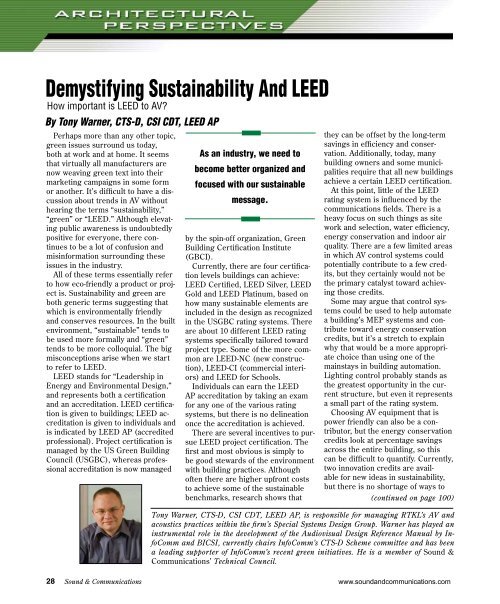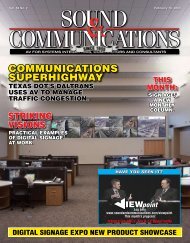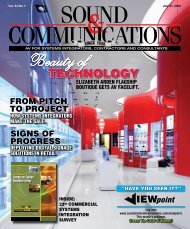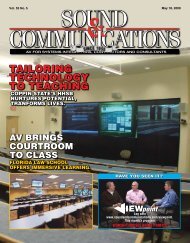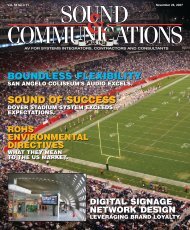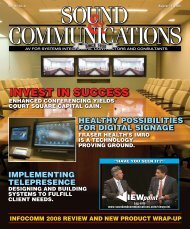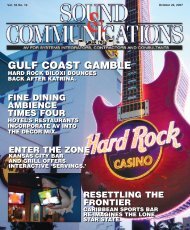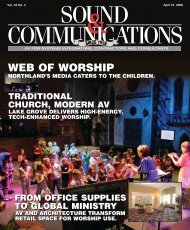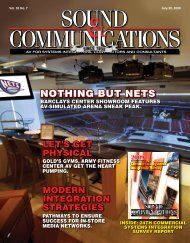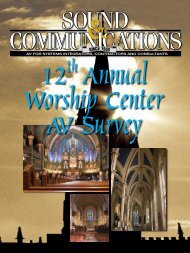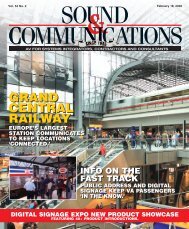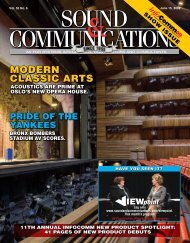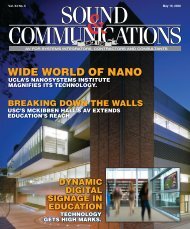Sound & Communications October 20, 2008 Issue
Sound & Communications October 20, 2008 Issue
Sound & Communications October 20, 2008 Issue
- No tags were found...
Create successful ePaper yourself
Turn your PDF publications into a flip-book with our unique Google optimized e-Paper software.
Demystifying Sustainability And LEEDHow important is LEED to AV?By Tony Warner, CTS-D, CSI CDT, LEED APPerhaps more than any other topic,green issues surround us today,both at work and at home. It seemsthat virtually all manufacturers arenow weaving green text into theirmarketing campaigns in some formor another. It’s difficult to have a discussionabout trends in AV withouthearing the terms “sustainability,”“green” or “LEED.” Although elevatingpublic awareness is undoubtedlypositive for everyone, there continuesto be a lot of confusion andmisinformation surrounding theseissues in the industry.All of these terms essentially referto how eco-friendly a product or projectis. Sustainability and green areboth generic terms suggesting thatwhich is environmentally friendlyand conserves resources. In the builtenvironment, “sustainable” tends tobe used more formally and “green”tends to be more colloquial. The bigmisconceptions arise when we startto refer to LEED.LEED stands for “Leadership inEnergy and Environmental Design,”and represents both a certificationand an accreditation. LEED certificationis given to buildings; LEED accreditationis given to individuals andis indicated by LEED AP (accreditedprofessional). Project certification ismanaged by the US Green BuildingCouncil (USGBC), whereas professionalaccreditation is now managedAs an industry, we need tobecome better organized andfocused with our sustainablemessage.by the spin-off organization, GreenBuilding Certification Institute(GBCI).Currently, there are four certificationlevels buildings can achieve:LEED Certified, LEED Silver, LEEDGold and LEED Platinum, based onhow many sustainable elements areincluded in the design as recognizedin the USGBC rating systems. Thereare about 10 different LEED ratingsystems specifically tailored towardproject type. Some of the more commonare LEED-NC (new construction),LEED-CI (commercial interiors)and LEED for Schools.Individuals can earn the LEEDAP accreditation by taking an examfor any one of the various ratingsystems, but there is no delineationonce the accreditation is achieved.There are several incentives to pursueLEED project certification. Thefirst and most obvious is simply tobe good stewards of the environmentwith building practices. Althoughoften there are higher upfront coststo achieve some of the sustainablebenchmarks, research shows thatthey can be offset by the long-termsavings in efficiency and conservation.Additionally, today, manybuilding owners and some municipalitiesrequire that all new buildingsachieve a certain LEED certification.At this point, little of the LEEDrating system is influenced by thecommunications fields. There is aheavy focus on such things as sitework and selection, water efficiency,energy conservation and indoor airquality. There are a few limited areasin which AV control systems couldpotentially contribute to a few credits,but they certainly would not bethe primary catalyst toward achievingthose credits.Some may argue that control systemscould be used to help automatea building’s MEP systems and contributetoward energy conservationcredits, but it’s a stretch to explainwhy that would be a more appropriatechoice than using one of themainstays in building automation.Lighting control probably stands asthe greatest opportunity in the currentstructure, but even it representsa small part of the rating system.Choosing AV equipment that ispower friendly can also be a contributor,but the energy conservationcredits look at percentage savingsacross the entire building, so thiscan be difficult to quantify. Currently,two innovation credits are availablefor new ideas in sustainability,but there is no shortage of ways to(continued on page 100)Tony Warner, CTS-D, CSI CDT, LEED AP, is responsible for managing RTKL’s AV andacoustics practices within the firm’s Special Systems Design Group. Warner has played aninstrumental role in the development of the Audiovisual Design Reference Manual by InfoCommand BICSI, currently chairs InfoComm’s CTS-D Scheme committee and has beena leading supporter of InfoComm’s recent green initiatives. He is a member of <strong>Sound</strong> &<strong>Communications</strong>’ Technical Council.28 <strong>Sound</strong> & <strong>Communications</strong>www.soundandcommunications.com


